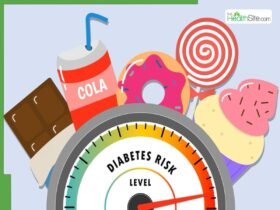Most of us will develop one (or both!) of these growths at some point in our lives, but it can be tricky to tell them apart—and know the best way to treat them. Read on for everything you need to know about skin tags vs. warts.
Skin tags vs. warts: What’s the difference?
Though both are growths on the skin and can sometimes look similar, skin tags and warts are actually vastly different.
Skin tags
Also called acrochordons, skin tags are fleshy outpourings of skin that can appear anywhere on the body. They tend to be soft-feeling, and may be large or small; the same color as your skin or pink-hued; fixed to the skin or dangling. But no matter how they look, skin tags are harmless, usually not painful, and very common—about half of the population will have at least one in their lifetime, according to Cleveland Clinic.
“They’re often formed in places of friction, such as in the underarms, around the neck, or even around the eyes due to rubbing,” says Maya K. Thosani, MD, an Arizona-based dermatologist who is double board-certified in dermatology and micrographic dermatologic surgery.
Warts
Warts are benign skin growths caused by human papilloma virus (HPV), which means they’re contagious. Like skin tags, they can vary in appearance, according to the American Academy of Dermatology (AAD): Some are covered in scaly skin and feel rough to the touch, while others are smooth. Warts can be white, brown, or gray-black, and may be raised or nearly flat.
TL;DR:
- Skin tags are typically caused by friction and can appear anywhere on the body, but usually crop up in places where skin rubs against clothing or jewelry. They can vary in color, shape, and size, but they tend to be soft and fleshy.
- Warts are contagious. Though they sometimes resemble skin tags, they’re usually thicker. They can have scaly skin that feels rough, but also may be smooth. Warts are most commonly found on the hands, per the AAD, though they can also appear on other parts of the body, too.
Skin tag causes
As we’ve noted, skin tags are usually caused by friction, so you’re likely to spot them on your groin, neck, underarms, eyelids, under the breasts, or on the abdomen or back, according to the AAD.
But: “They can be associated with weight gain and insulin resistance,” says Dr. Thosani. “And they are more common in pregnancy, in people with diabetes, and in those with metabolic syndrome, where high blood pressure and high blood glucose levels combine with elevated cholesterol [and lead to] excess fat around the waist.”
Warts causes
Warts form when HPV infects the top layer of the skin, often because there’s a scrape or cut that makes it easier for the virus to enter the body. (That’s why it’s so important to keep skin moisturized so fewer cracks emerge, as well as cover cuts with a bandage and avoid touching another person’s warts.)
“They’re more common in children overall, as their immune systems are learning to recognize [the virus],” says Dr. Thosani.
Though warts are non-cancerous, they’re caused by different strains of HPV, some of which are considered more dangerous because they can be associated with a higher risk of developing certain cancers. Your dermatologist can perform a biopsy of the wart if you’re concerned about the specific strain of HPV that’s caused it, Dr. Thosani says, but it’s usually not necessary.
Remember, warts are contagious, which means it’s possible for the virus that causes them to spread to other people in a household. To prevent this, the AAD recommends washing your hands often, making sure everyone uses their own towels (as well as other personal items that touch the skin like razors and nail clippers), keeping cuts and scrapes covered, and trying not to bite your nails, which can create small tears in the skin that allow HPV to enter the body.
How to remove skin tags
Don’t even think about trying to remove a skin tag at home—doing so can be dangerous and up your risk of developing an infection, experts say.
Instead, your dermatologist can remove a skin tag using a variety of in-office methods, such as cryosurgery (which uses liquid nitrogen to freeze the skin tag), electrodessication (best for smaller skin tags), and snip removal (your dermatologist will use local anesthesia to numb the base of the skin tag and remove it with scissors).
But because skin tags are harmless, the AAD only recommends having them removed if they become irritated or start to bleed (this can happen if they frequently rub against your clothes or jewelry), are painful, or have developed near your eyelid and affect your eyesight.
Some people would still prefer to have a “non-bothersome” skin tag removed. If that’s the case, ask your dermatologist for their advice on the best method and your pricing options. Keep in mind that skin tag removal isn’t always covered by insurance if it’s not causing any medical problems such as pain or loss of vision.
How to remove warts
Many warts go away on their own without treatment, the Mayo Clinic says, but it can take a few months for them to subside. In the meantime, your dermatologist can evaluate any warts and remove them if you’d prefer. Depending on the wart’s appearance and your skin, your dermatologist might recommend:
- Cryosurgery spray: Also referred to as “freezing therapy,” your derm will use liquid nitrogen to create an injury that signals to your body’s immune system that it should attack and eliminate the virus causing the wart. In people with darker skin tones, however, this method can create a temporary dark spot, Dr. Thosani says.
- Cantharidin: This blister beetle extract is “painted” on the skin, causing a blister to form under the wart. “In a week or so, you can return to the office and the dermatologist will clip away the dead wart,” says Dr. Thosani.
- Chemical peels: This is often prescribed for areas of the skin that have many flat warts, Dr. Thosani says. It involves applying a prescription-strength peeling medicine (such as salicylic acid, tretinoin, or glycolic acid) to treat the warts.
- Excision: This is just what it sounds like: Your derm will conduct a minor surgery to cut out the wart.
There are also over-the-counter wart removers available, most of which contain salicylic acid. It’s okay to try an OTC treatment first if you prefer or aren’t able see a dermatologist, but know that most of these formulas must be applied daily for several weeks. Plus: “The OTC ‘freeze off’ spray is completely different than the liquid nitrogen that is used in dermatology offices and often ineffective and may cause discoloration,” Dr. Thosani warns.
When to see a doctor
You should reach out to your doctor anytime you’re concerned or have questions about a skin tag (or simply want confirmation that’s what you have—sometimes it can be hard to tell!). But it’s especially important to seek medical care if you notice any of the following:
- The skin tag is bleeding
- It seems to get irritated very easily
- It’s growing near your eyes and affecting your vision
- The skin tag is suddenly painful (“this can indicate the blood supply is blocked or twisted,” says Dr. Thosani)
Warts, on the other hand, are more likely to require a doctor’s input, especially because they’re caused by a virus and can spread.
Reach out to your practitioner if:
- You’ve tried to remove the wart at home using over-the-counter treatments, but it isn’t responding
- Your warts are treatment-resistant, especially if they’re on thick areas of the skin such as the hands and feet
- You have several warts that are spreading
- You have a “wart” that seems to have been present for a long time (your dermatologist can check to make sure it’s not something more serious)
FAQs
Can you put wart remover on a skin tag?
Dermatologists advise against trying this for a few reasons, but primarily because it wouldn’t be effective. “Wart remover is salicylic acid, and it will cause skin irritation and discomfort, but won’t remove the cells or the fleshy base of the skin tag,” says Dr. Thosani. What’s more, irritation caused by too much salicylic acid can cause pigment changes and scarring.
What does an HPV skin tag look like?
Some research1 has suggested that nearly half of skin tags contain serotypes for a low-risk form of HPV. “This [serotype] can cause small filiform tags,” says Dr. Thosani, which mean they’re long and thin. But these can look identical to regular skin tags, she adds.
What are skin tags a warning for?
While skin tags themselves are harmless, they’re sometimes associated with other conditions that require treatment. People with diabetes may have a higher risk of skin tags, for example, as do those with unhealthy cholesterol levels or metabolic syndrome.
It’s also important to let your doctor know if you suddenly start developing many skin tags in a short period of time. “This can very rarely be associated with endocrine dysfunction or hormonal imbalances,” Dr. Thosani says.
Well+Good articles reference scientific, reliable, recent, robust studies to back up the information we share. You can trust us along your wellness journey.
-
Gupta S, Aggarwal R, Gupta S, Arora SK. Human papillomavirus and skin tags: is there any association? Indian J Dermatol Venereol Leprol. 2008 May-Jun;74(3):222-5. doi: 10.4103/0378-6323.39585. PMID: 18583787.













Leave a Reply